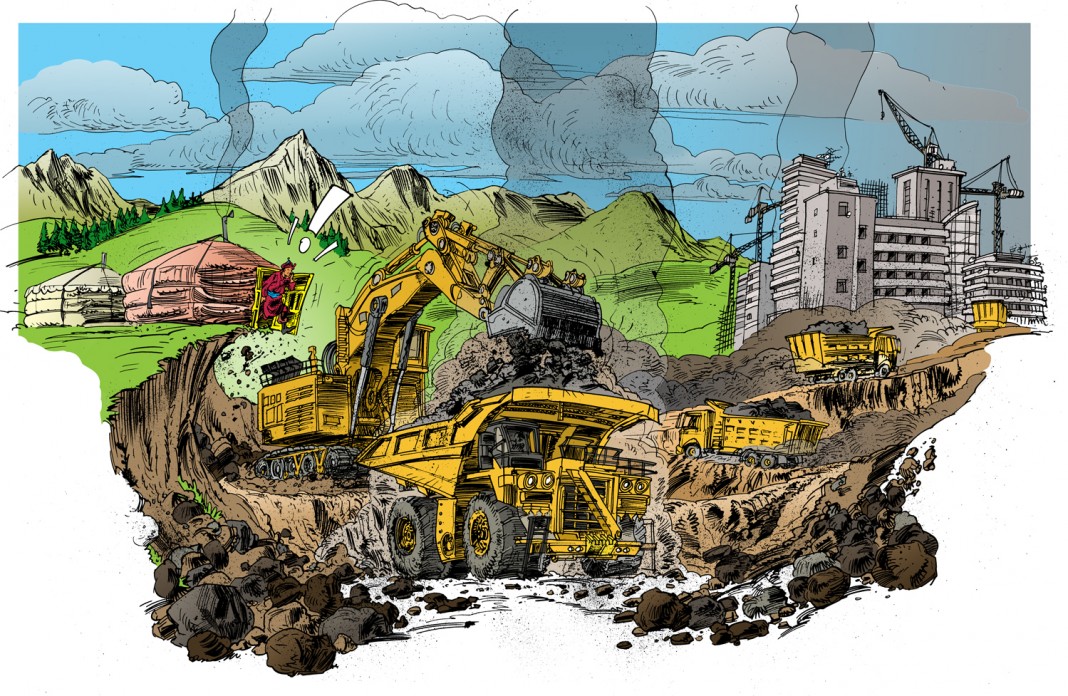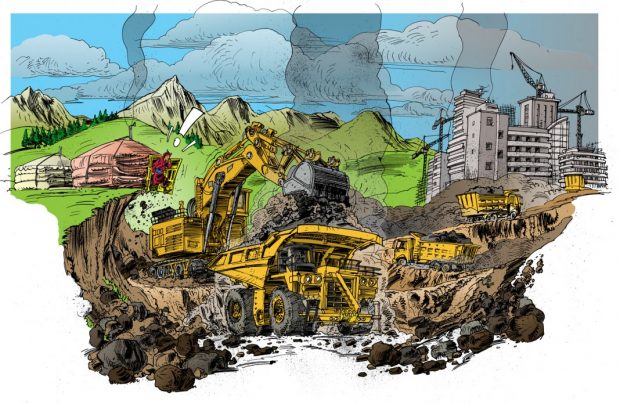
What comes next after mining?
Chintushig Boldsukh – The UB Post
Ever since the 2001 discovery of the Oyu Tolgoi mine by Ivanhoe Mines, there has been an equal amount of optimism and cautionary sentiment regarding the use of the resource model to develop the economy. While many have recognized the potential that a thriving mining industry can have for an economy, detractors have cited the dangers that over reliance on mining can have and the environmental damage it could cause.
There are many arguments to be made regarding whether or not it is right for the economy to be based on natural resources. The reality of the situation is that mining has become the primary driver of economic growth in the country. It is not realistic to go back and try to change the model of development that our government has chosen. On the contrary, our main priority should be to maximize and reap the benefits of mining while also studying and implementing ways to diversify the economy and ideally move away from mining. So, what comes next?
Questions about how a country with 20 times more livestock than people can diversify its economy arise. The potential answer lies within the question. According to a 2015 livestock census by the National Registration and Statistical Office, Mongolia has around 55.9 million livestock. According to a July 2016 estimate, the population of the country stands at 3.03 million. These two contrasting numbers show that the country has enough resources and the capacity to not only supply the population but to export large volumes of animal products. The numbers show that the country has a major surplus, which if utilized to its full potential, could be just as integral to the economy as mining. Livestock has been seen as a potential “gold mine” by many economists, and it offers a wide array of products. Cashmere, meat, leather, wool, and a host of other products have the potential to be exported to foreign markets. The two main problems that have held back the development of such exports are transportation and animal health issues. Being a landlocked country with extreme weather is a major setback in terms of transportation, the price of transportation has been a major factor in keeping the prices for exports from being competitive. The government has led large scale projects to develop railways in the hope of cutting transportation costs, but these efforts have largely been ineffective due to bureaucratic problems and mismanagement.
The other looming issue with the export of animal products has been the health of livestock. In terms of international standards, livestock in Mongolia has been deemed unhealthy due to outbreaks of disease. China’s temporary ban on meat imported from Mongolia is still in place. Russia has expressed willingness to import animal products, but has also been hesitant due to concerns about health. There have been efforts to improve the health of livestock by drafting legislation that address veterinary hospitals and the management of livestock. Better management of animal health could potentially open Mongolia up to China’s market with a population of 1.37 billion people. If the transportation and the health issues are addressed correctly, and China is willing to import, Mongolia could export meat only to China and it would be enough to sustain the sector.
This is not to mention the environmental benefits that exporting agricultural products could have. Studies have shown that the overpopulation of livestock, especially goats, has intensified desertification in the country. If exports become regular and large in volume, the government would be better able to manage livestock and increase the efficiency of the sector.
While livestock provides an ideal alternative to mining, it would be negligent to ignore the effects that a commercialized livestock industry would have on the environment. The commercialization of livestock, coupled with mining, could have disastrous effects on the often touted “undisturbed” nature of the country. While animal products offer a good short- term solution to the economic diversity problem, it may not be environmentally sustainable.
Another sector that people often bring up for diversification is manufacturing. Manufacturing is advantageous in that it creates jobs and can be made sustainable. However, in Mongolia’s case, developing mass manufacturing seems like a pipe dream when China has essentially monopolized the global manufacturing market. It seems like an insurmountable task to compete with a country with a workforce of 770 million people. However, this does not mean that we should rule out the potential of manufacturing. The country had a self-sustaining manufacturing industry that produced a wide array of products during socialist times. There is potential to at least develop factories to meet domestic demand and decrease imports. While it is virtually impossible for the country to compete in global mass manufacturing, there are many niche markets that Mongolia could focus on. Just as the Belgians are famous for their chocolate, Mongolia could focus on a small number of products, such as sea buckthorn. There isn’t a need for Mongolia to try to compete in multiple markets already dominated by large countries. Products that symbolize the Mongolian spirit and culture could be effective in penetrating foreign markets. However, as mentioned before, transportation and the infrastructure are the biggest obstacles to the development of these types of exports.
Agriculture and manufacturing have the potential to eliminate the country’s increasing reliance on mining. Mining is not a sustainable economic model; we have seen how the boom and bust cycles affect the country. Being over reliant on mining can leave an economy vulnerable to these cycles. This is not to mention the global trend of shifting away from fossil fuels. Although the world has not fully shifted away from mining and fossil fuels, it is becoming more and more likely as the threat of climate change becomes more evident. What this means for Mongolia is that now is the time to use mining as a stepping stone to a more sustainable economic model. Especially now, when commodity prices have resurged, better management of exports could help finance the manufacturing and agricultural sectors.
The bottom line is that although there are only two key sectors mentioned here, Mongolia has a wide array of economic opportunities. The service industry and information communications sector were not mentioned, but there is no denying the potential these sectors have. Manufacturing and livestock are seen as the two largest avenues for economic diversification, and with improved management, these two sectors could quickly be taken to a new level. It is imperative that the government and the general public realize the potential of other sectors and the importance of economic diversification, and begin taking action now instead of later.



